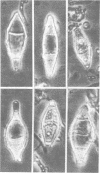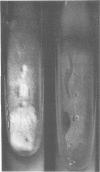Abstract
Microsporum equinum was isolated in Ontario, Canada, from five human and two equine cases of ringworm infection. This dermatophyte was previously recovered from North American horses on several occasions, but was considered to be M. canis. We regard M. equinum as distinct from M. canis. It can be differentiated from M. canis by the smaller size of its macroconidia, its failure to perforate hair in vitro, its poor growth and sporulation on bromocresol purple casein dextrose agar, and its incompatibility with Nannizzia otae, the telemorph of M. canis.
Full text
PDF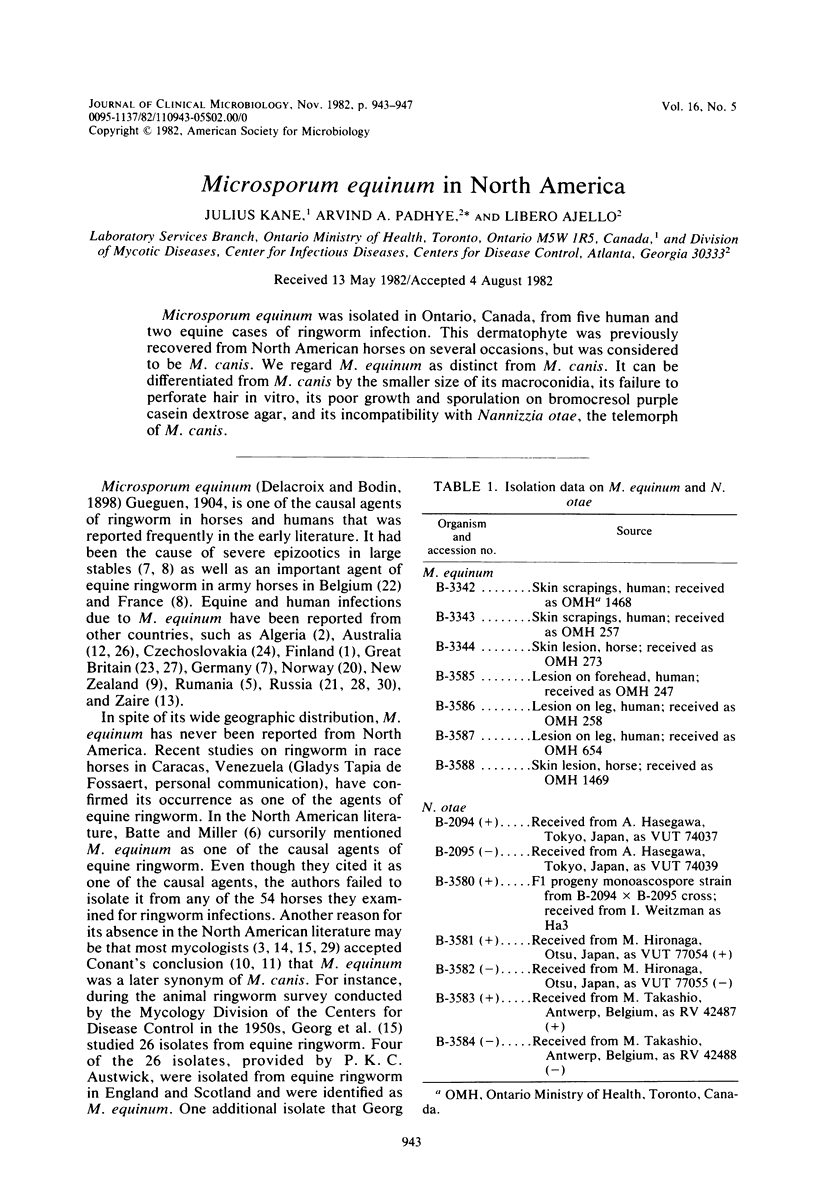
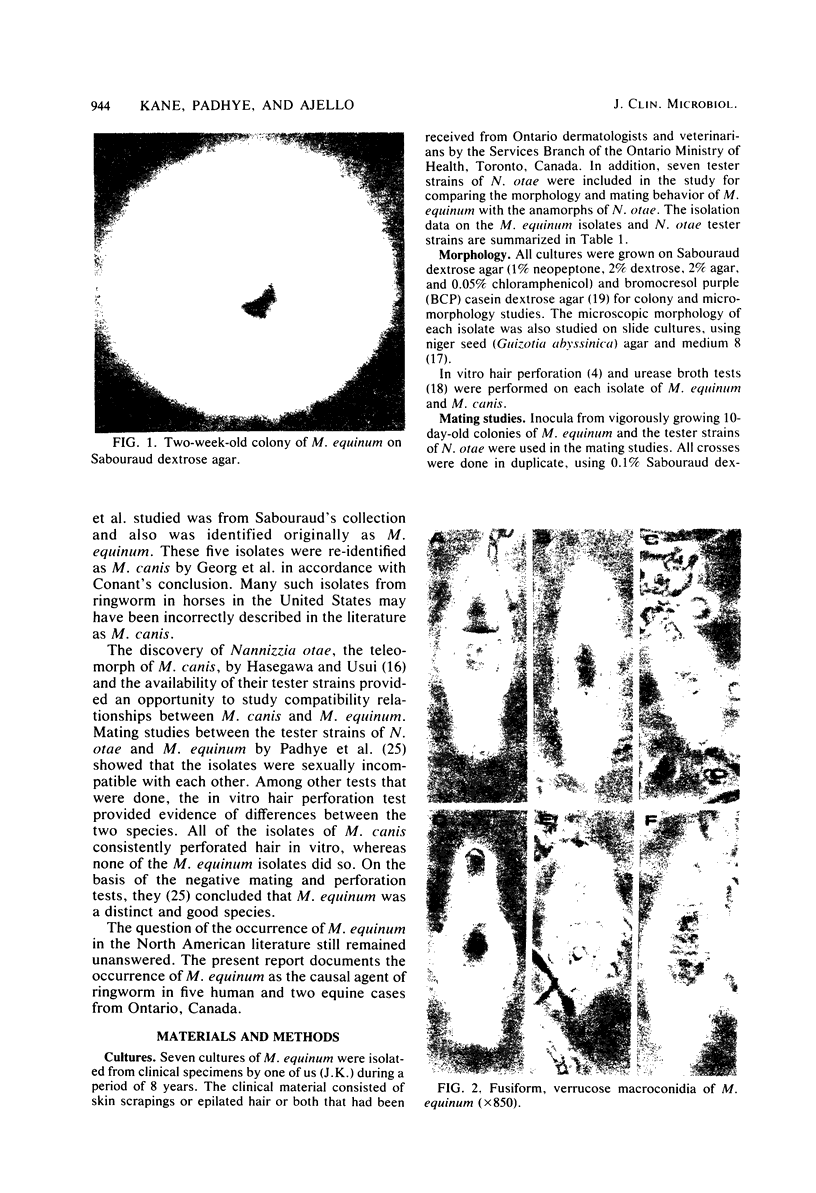
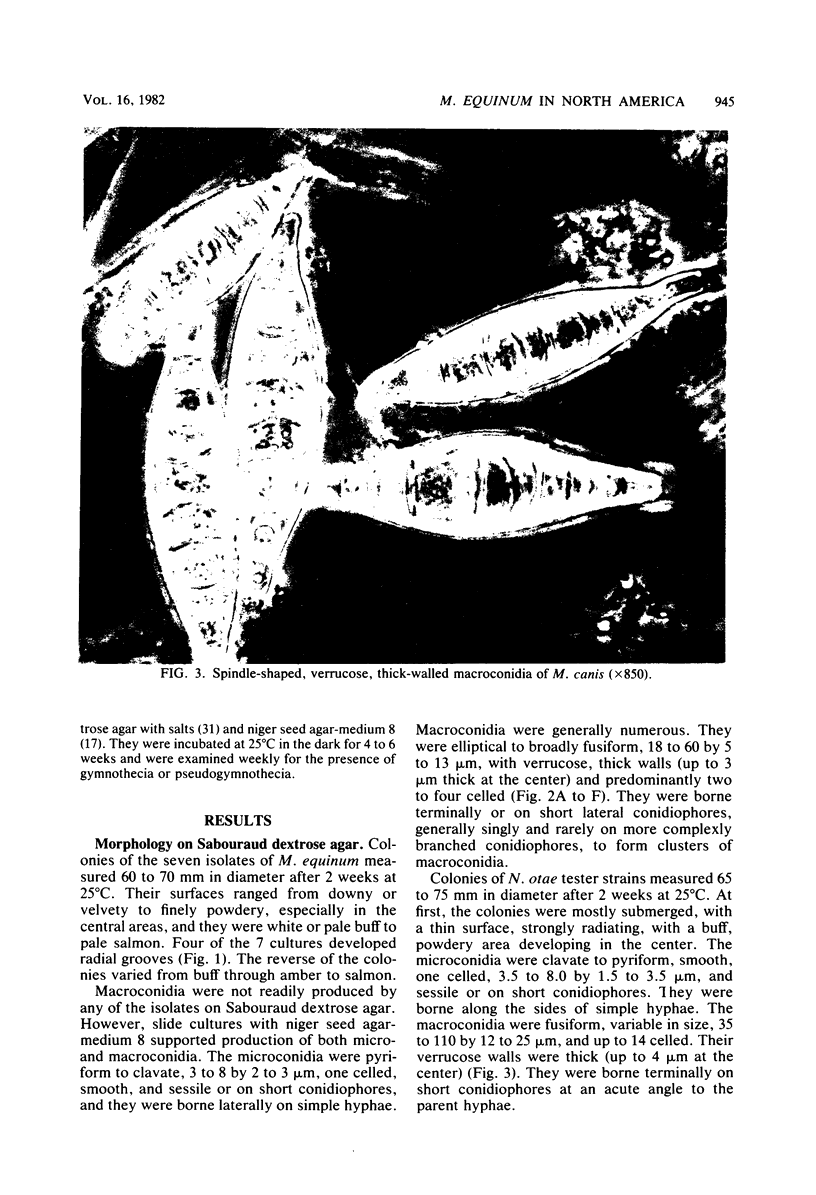
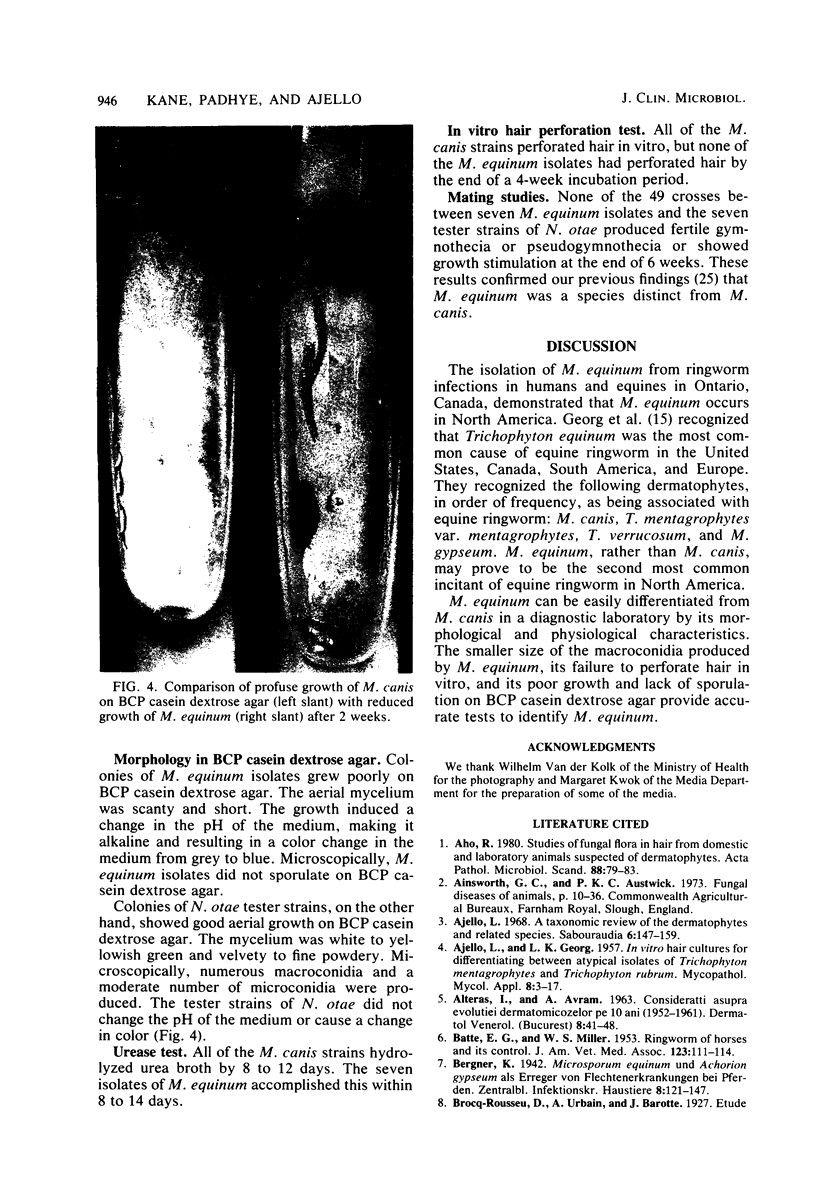
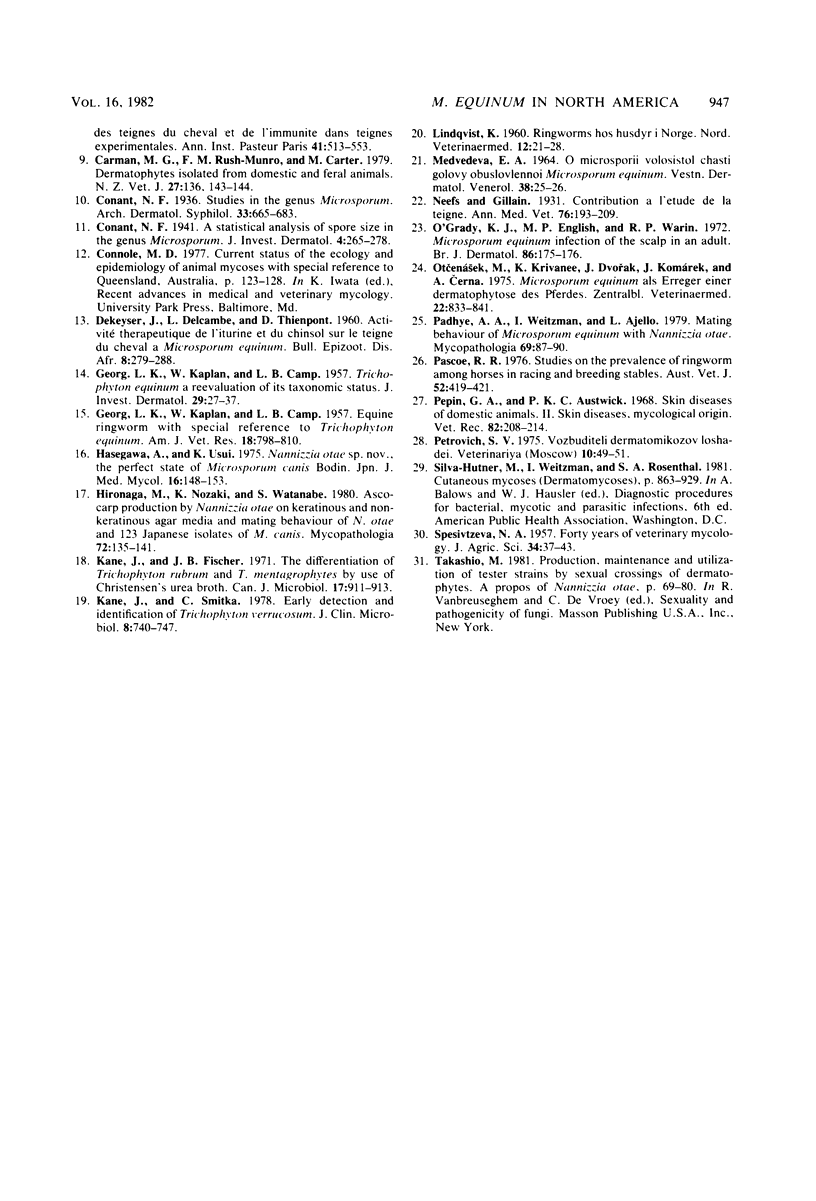
Images in this article
Selected References
These references are in PubMed. This may not be the complete list of references from this article.
- AJELLO L., GEORG L. K. In vitro hair cultures for differentiating between atypical isolates of Trichophyton mentagrophytes and Trichophyton rubrum. Mycopathol Mycol Appl. 1957 Mar 25;8(1):3–17. doi: 10.1007/BF02053114. [DOI] [PubMed] [Google Scholar]
- Aho R. Studies on fungal flora in hair from domestic and laboratory animals suspected of dermatophytosis. I. Dematophytes. Acta Pathol Microbiol Scand B. 1980 Apr;88(2):79–83. doi: 10.1111/j.1699-0463.1980.tb02609.x. [DOI] [PubMed] [Google Scholar]
- Ajello L. A taxonomic review of the dermatophytes and related species. Sabouraudia. 1968 Feb;6(2):147–159. doi: 10.1080/00362176885190271. [DOI] [PubMed] [Google Scholar]
- BATTE E. G., MILLER W. S. Ringworm of horses and its control. J Am Vet Med Assoc. 1953 Aug;123(917):111–114. [PubMed] [Google Scholar]
- Carman M. G., Rush-Munro F. M., Carter M. E. Dermatophytes isolated from domestic and feral animals. N Z Vet J. 1979 Jul;27(7):136, 143-4. doi: 10.1080/00480169.1979.34628. [DOI] [PubMed] [Google Scholar]
- GEORG L. K., KAPLAN W., CAMP L. B. Equine ringworm with special reference to Trichophyton equinum. Am J Vet Res. 1957 Oct;18(69):798–810. [PubMed] [Google Scholar]
- GEORG L. K., KAPLAN W., CAMP L. B. Trichophyton equinum; a re-evaluation of its taxonomic status. J Invest Dermatol. 1957 Jul;29(1):27–37. doi: 10.1038/jid.1957.69. [DOI] [PubMed] [Google Scholar]
- Hironaga M., Nozaki K., Watanabe S. Ascocarp production by Nannizzia otae on keratinous and non-keratinous agar media and mating behavior of N. otae and 123 Japanese isolates of Microsporum canis. Mycopathologia. 1980 Nov 28;72(3):135–141. doi: 10.1007/BF00572655. [DOI] [PubMed] [Google Scholar]
- Kane J., Fischer J. B. The differentiation of Trichophyton rubrum and T. mentagrophytes by use of Christensen's urea broth. Can J Microbiol. 1971 Jul;17(7):911–913. doi: 10.1139/m71-145. [DOI] [PubMed] [Google Scholar]
- Kane J., Smitka C. Early detection and identification of Trichophyton verrucosum. J Clin Microbiol. 1978 Dec;8(6):740–747. doi: 10.1128/jcm.8.6.740-747.1978. [DOI] [PMC free article] [PubMed] [Google Scholar]
- MEDVEDEVA E. A. O MIKROSPORII VOLOSISTO'I CHASTI GOLOVY, OBUSLOVLENNO'I MICROSPORUM EQUINUM. Vestn Dermatol Venerol. 1964 Feb;38:25–26. [PubMed] [Google Scholar]
- O'Grady K. J., English M. P., Warin R. P. Microsporum equinum infection of the scalp in an adult. Br J Dermatol. 1972 Feb;86(2):175–176. doi: 10.1111/j.1365-2133.1972.tb16083.x. [DOI] [PubMed] [Google Scholar]
- Otcenásek M., Krivanec K., Dvorák J., Komárek J., Cerná A. Microsporum equinum als Erreger einer Dermatophytose des Pferdes. Zentralbl Veterinarmed B. 1975 Dec;22(10):833–841. [PubMed] [Google Scholar]
- Pascoe R. R. Studies on the prevalence of ringworm among horses in racing and breeding stables. Aust Vet J. 1976 Sep;52(9):419–421. doi: 10.1111/j.1751-0813.1976.tb09515.x. [DOI] [PubMed] [Google Scholar]
- Petrovich S. V. Vozbuditeli dermatomikozov loshadei. Veterinariia. 1975 Oct;(10):49–51. [PubMed] [Google Scholar]




